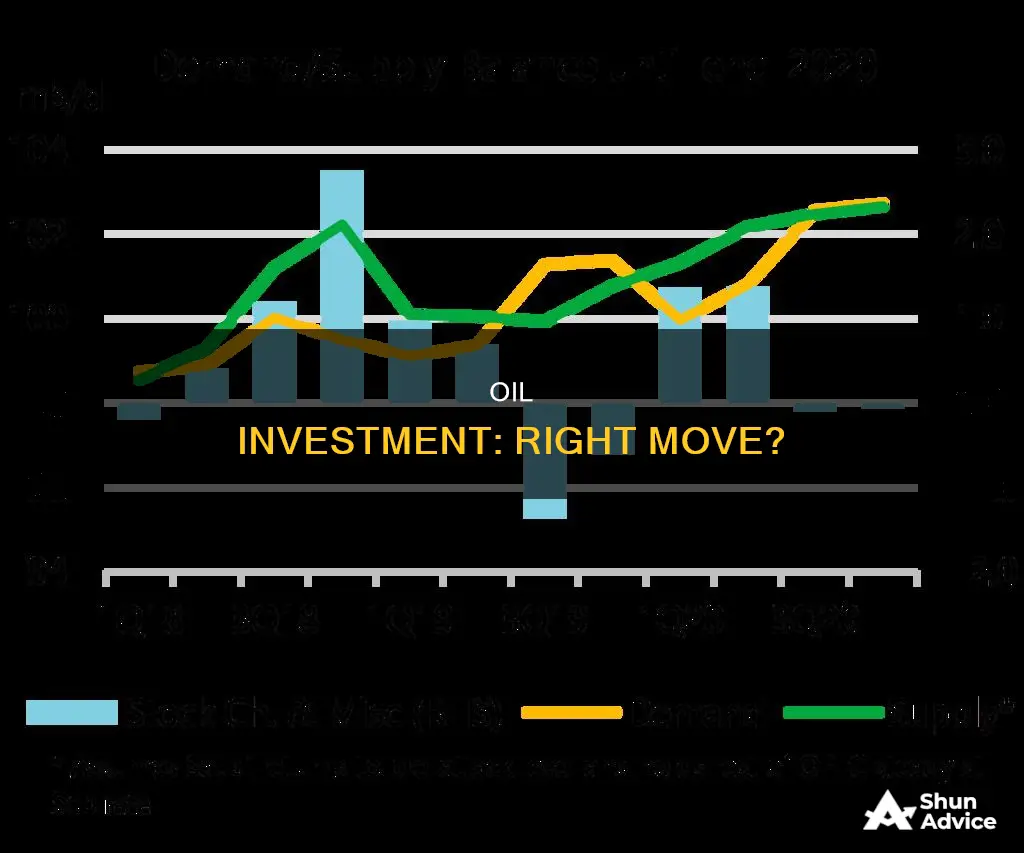
Investing in oil is a tricky question. While oil remains a key facet of the global economy, the market is precarious and has seen radical ups and downs over the past few years. Oil prices can be volatile, and profits and losses can swing wildly based on small shifts in demand or geopolitical events.
For example, in 2020, the COVID-19 pandemic destroyed demand, causing oil investments to tank. However, in 2022, oil and gas prices skyrocketed, with crude oil costing over $111 per barrel.
Oil and gas stocks tend to be more volatile than the broader market as they are sensitive to changes in the supply and demand of the underlying commodities. The industry is also highly competitive, and companies must navigate legal and regulatory risks, as well as the possibility of accidents, such as oil spills, which can cause a company's share price to plummet.
On the other hand, oil and gas stocks can be attractive buys when they are down, and there is the potential for significant profits if the investments are timed wisely. Additionally, oil companies are crucial to the global economy, providing fuels for transportation, power, and the core ingredients for many products.
So, should you invest in oil right now? It's impossible to time the market perfectly, but with prices currently on the rise, there may be limited gains and a higher risk of loss once the rally is over. However, for those looking for a long-term investment, oil and gas may still be a good option, especially if you can find companies that are focused on going green.
| Characteristics | Values |
|---|---|
| Current oil price | High |
| Oil demand | Expected to outstrip supply for years to come |
| Oil as an investment | High-risk, volatile, but potentially profitable |
| Oil vs renewable energy | Renewable energy has tremendous growth potential |
| Oil companies | Dividends can be cut if the company is unable to earn enough revenue |
What You'll Learn

Oil stocks vs renewable energy stocks
Overview
The energy sector is vital to the global economy, providing the fuel and power needed for trade and travel. However, the industry is facing a massive transition to renewable energy, causing investors to question the future of oil stocks. While oil remains crucial, renewable energy stocks are increasingly attractive due to their growth potential and alignment with the global shift towards cleaner energy sources.
Oil Stocks
Advantages
- Oil is still a key facet of the global economy, providing fuels for transportation, power, and various industrial products like plastics and rubber.
- Oil companies can be profitable, especially during high oil price environments, and some offer attractive dividends.
- Oil prices are expected to remain favourable in the short term, and the transition to renewable energy will take decades.
Disadvantages
- The oil industry is highly competitive and volatile, with profits fluctuating based on small shifts in demand or geopolitical events.
- Climate change and the push for renewable energy sources may impact the long-term prospects of oil companies.
- Oil spills and negative press can negatively impact stock prices.
Renewable Energy Stocks
Advantages
- Renewable energy demand is expected to grow exponentially, changing the dynamics of the energy sector.
- Renewable energy companies, particularly in wind and solar power, are becoming increasingly competitive with traditional energy sources.
- Renewable energy stocks offer strong growth potential and are better aligned with the global shift towards cleaner energy.
- Some renewable energy companies provide stable dividend income, similar to oil stocks.
Disadvantages
- Investing in renewable energy companies may be riskier as the industry is relatively new and subject to technological advancements and market changes.
- Some renewable energy sources, like wind and solar, are dependent on specific conditions (e.g., wind, sunlight) and may not be as reliable as traditional energy sources.
Both oil stocks and renewable energy stocks offer investment opportunities, but they come with different risks and potential rewards. Oil stocks may provide more stable and predictable returns in the short term, especially with the current high oil prices. However, renewable energy stocks are likely to gain more traction in the long term due to the global energy transition. A balanced portfolio that includes a mix of both could be a prudent strategy.
Smartly Choosing Your Investment Portfolio
You may want to see also

The impact of oil price volatility
For example, in 2008, the IMF's Average Petroleum Spot Price was $115 a barrel. Two months later, it had risen to $135. By the end of the year, it stood at $36, and in the following days, it fluctuated around $45. Such dramatic price variations over a short period had significant consequences for oil consumers and producers, as well as policymakers worldwide.
The volatility of oil prices is inherently tied to the low responsiveness or "inelasticity" of both supply and demand to price changes in the short run. It takes years to develop new supply sources or vary production, and it is challenging for consumers to switch to other fuels or increase fuel efficiency when prices rise. As a result, a large price change is often necessary to re-balance physical supply and demand following a shock to the system.
Oil price volatility can also be influenced by geopolitical events, weather-related developments, and refinery or pipeline issues. For instance, the Arab Oil Embargo in 1973-74, the Iranian Revolution and Iran-Iraq War in the late 1970s and early 1980s, and the Persian Gulf War in 1990 all contributed to major oil price shocks. More recently, disruptions to supply or curbs on potential resource development from political events have been seen in Nigeria, Venezuela, Iraq, Iran, and Libya.
Additionally, oil prices tend to be more volatile than many other commodity or asset prices, and the presence of high volatility is often associated with claims that markets are overshooting relative to underlying fundamentals. However, this may not always be the case, as changes in underlying economic fundamentals can lead to complicated price dynamics. For example, the dramatic decline in oil prices since July 2008 was a response to an unexpectedly rapid and sharp deterioration in near-term global economic growth prospects.
To manage oil price volatility, policies should focus on strengthening the responsiveness of domestic end-user prices to changes in market conditions and providing well-targeted subsidies to protect vulnerable groups. On the supply side, stable and predictable investment and tax regimes, as well as greater cooperation and synergies between national and international oil companies, can help encourage adequate investment. Improving market transparency and regulatory oversight can also help maximize the benefits of financialization while reducing potential risks to price stability.
Options: Why Investors Are Wary
You may want to see also

Oil companies and their dividend payments
Dividend payments are a favoured topic for academics. Dividend cuts in the oil and gas industry are awkward, and oil majors have been considered low-risk businesses generating stable returns and allowing for regular dividends. Before cutting dividends, managers have to think twice. For example, Exxon Mobil has increased its dividend year after year for over three decades. This is not a singularity; other majors have adopted a similar approach.
In 2015, the Italian oil & gas leader, ENI, decided on a 40% dividend cut, and its share price fell by about 5% immediately after the announcement. This is a good illustration of signalling theory, one of the most popular theories used to reflect on dividend policy. When deciding on dividends, managers send a signal to investors. Maintaining or increasing dividends suggests optimistic anticipations about future cash flows. Conversely, when ENI decided to cut dividends and abandon a share buyback program, it signalled to investors a certain degree of pessimism or perplexity about the industry's future.
In 2015, nearly 80% of large oil and gas companies (above $10 billion in market cap) maintained or increased their dividend payments, and this proportion was estimated to remain the same in 2016. This is astonishing when one considers that these companies were struggling to generate cash in a context of depressed prices. It is even more astonishing when one realises that investment expenses had to be reduced, operating assets sold, and more debt taken on to finance this generous dividend policy.
One possible explanation for this is agency theory. Information asymmetry is a concern for shareholders since well-informed managers are likely to pursue their own objectives first rather than create value for shareholders. A typical solution to this problem is to align the objectives of both parties, and stock options were theoretically expected to achieve that. However, it has become apparent that it is also necessary to maintain a certain pressure on managers to better control their actions. The threat is particularly significant when the company is cash-rich, as managers do not need to rely on external funds to finance their plans. In this case, imposing a high payout ratio and increasing the debt service is a way to limit managers' easy access to cash and, thus, their autonomy.
Looking at the past performance of oil and gas firms, shareholders may have good reasons to ask for their money to impose a cash constraint on managers. As noted in a 2015 report by Deloitte, "Returns of private global oil companies peaked a decade ago, well before crude hit record highs, indicating that they squandered the boom on vanity projects aimed at increasing production, with little thought for profitability."
In the present situation, the problem is that ENI is probably right, and the future of oil and gas companies is very uncertain. Then how can one justify the positive attitude of others? Can one reasonably assume that most managers are confident enough to consider that oil and gas prices will definitely come back to a sustainable level soon? If that is not realistic, what else is driving their decision?
At this stage, it is worth considering the possibility that investors have changed their minds about the future of the oil and gas industry, considering that it has now entered its declining phase. Even if the weight of fossil fuels is expected to decrease, oil and gas will remain a dominant source of primary energy. However, the climate change issue is gaining momentum, and energy companies will be affected by climate policies.
In conclusion, while dividend payments from oil companies can be attractive, the future of the industry is uncertain, and there are risks for investors. Oil companies are facing pressure to transition to renewable energy, and their profitability may be affected by negative externalities, such as the growing importance of Socially Responsible Investments (SRI) funds and green campaigns. Additionally, geopolitical tensions and the resulting increased difficulty of operating in some regions could further impact financial performance. Therefore, investors should carefully consider the risks and rewards of investing in oil companies and their dividend payments.
Training Investments: Why Bother?
You may want to see also

The risks of oil spills and accidents
Oil spills can have disastrous consequences for society, the economy, the environment, and human health. They can be caused by human error, natural disasters, technical failures, or deliberate releases.
The Impact of Oil Spills on Human Health
Oil spills can have serious short- and long-term health effects on oil workers, people who live nearby, and first responders. The fumes and chemical reactions resulting from an oil spill can cause dizziness, irritability, and coughing. They can also lead to mental health issues such as depression, anxiety, and post-traumatic stress. Long-term health effects may include low platelet counts, low hemoglobin levels, respiratory problems, and an increased risk of cancer and reproductive issues.
The Impact of Oil Spills on the Environment
Oil spills can harm animals, plants, and the marine ecosystem. Oil penetrates the plumage of birds and the fur of mammals, reducing their insulating ability and making them more vulnerable to temperature changes. It can also impair a bird's ability to fly and affect their digestive tract, liver, and kidney function. Oil spills can contaminate drinking water supplies, leading to the closure of beaches, parks, and fisheries.
The Economic Impact of Oil Spills
Oil spills can have detrimental economic consequences for local and regional economies. They can lead to a decline in tourism as recreational activities such as swimming, boating, and angling are disrupted. Media attention and negative publicity can further drive tourists away, exacerbating the economic losses. Oil spills can also result in fishing closures and a decline in demand for seafood, impacting the fishing industry. Additionally, the equipment and boats of fishermen may be damaged by the oil.
The Social Impact of Oil Spills
Oil spills can bring about intense media attention and political uproar, leading to a struggle concerning government response and prevention measures.
China's Bubble: Global Investment Risk
You may want to see also

The future of oil demand
The Case for Continued Oil Demand
Oil remains a crucial facet of the global economy, providing transportation fuels, power, and core ingredients for petrochemicals used in plastics, rubber, and fertilizers. Despite the push for renewable energy, several factors suggest that oil demand will persist or even increase in the short to medium term.
Firstly, oil demand is expected to remain robust in the transportation sector, particularly in aviation. The shift to electric vehicles (EVs) is underway, but the existing fleet of internal combustion engine cars will keep oil demand high for the next few years. Additionally, the aviation industry's reliance on oil is challenging to replace with cleaner alternatives.
Secondly, oil-producing countries, particularly those outside the OPEC+ alliance, are planning to increase their supply capacity. The United States, Brazil, and Guyana are expected to lead this expansion, resulting in a net capacity gain for OPEC+ members as well.
Lastly, the transportation, aviation, and petrochemicals sectors will continue to rely on oil, and emerging and developing economies will drive demand. Countries like China, India, and the United States are projected to increase their oil consumption, with China's demand expected to rise due to growing car ownership and aviation fuel needs.
The Case for Declining Oil Demand
On the other hand, there are indications that the growth in global oil demand will slow down significantly by 2028. The high prices and supply concerns caused by the global energy crisis are accelerating the transition to cleaner energy technologies. The expansion of electric vehicles, the growth of biofuels, and improvements in fuel economy are expected to reduce oil consumption for transportation after 2026.
Additionally, renewable energy sources are becoming more prevalent, and their costs are declining. The US Energy Information Administration projects that renewables will account for 42% of US electricity generation by 2050, reducing the demand for oil in the power generation sector.
Moreover, the cyclicality of the oil industry and the global commitment to addressing climate change cannot be ignored. While a complete shift away from oil may take decades, investors must consider the long-term implications of these factors on oil demand and the potential risks to their investments.
In conclusion, the future of oil demand is complex and subject to various economic, geopolitical, and technological factors. While oil will remain important in the short to medium term, the transition to cleaner energy technologies and the push for renewable sources are expected to slow down demand growth and potentially lead to a peak in demand before the end of this decade.
Therefore, when considering investing in oil, it is essential to stay informed about market dynamics, carefully assess the risks, and potentially diversify your portfolio to include renewable energy investments.
Smart Ways to Invest $100,000
You may want to see also
Frequently asked questions
Oil stocks tend to be more volatile than the broader market as they are sensitive to changes in the supply and demand of the underlying commodities. Oil prices have been on the rise, and West Texas Intermediate (WTI) prices are up more than 35% overall in the past three years. However, trying to invest in oil and gas at current prices could leave you with little to gain and much to lose once gas and oil prices even out.
There are several risks associated with investing in the oil and gas industry, including commodity price volatility risk, the possibility of dividend cuts, and the risk of accidents such as oil spills. Oil companies are also exposed to legal and regulatory risks that can arise from accidents.
Some of the top oil stocks to consider include ConocoPhillips, Devon Energy, Enbridge, ExxonMobil, and Phillips 66. These companies have strong financial profiles, low-cost operations, and diversified businesses that can help mitigate the risks associated with the volatile nature of the oil industry.







